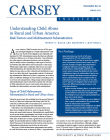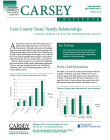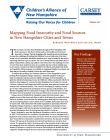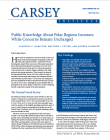Publications

June 12, 2012
This brief analyzes employed parents’ access to five or more paid sick days annually to care for a sick child in 2008.

May 30, 2012
Using a large national sample of child maltreatment reports, this brief compares the outcomes of child maltreatment cases in rural versus urban places and identifies the characteristics associated with substantiation. Child abuse cases substantiated in rural and urban areas share many caregiver risk factors, such as drug and alcohol abuse, and many family stressors.

May 22, 2012
This brief uses data from the 2007 and 2010 American Community Survey to document changes in the proportion of household income spent on rental costs (rent plus utilities) during the Great Recession, by region (Northeast, Midwest, South, and West) and place type (rural, suburban, or central city location).

May 15, 2012
This brief examines the impact of state-level adoption of Earned Income Tax Credits (EITCs) on a set of health-related outcomes for children, including: (1) health insurance coverage, (2) use of preventive medical and dental care, and (3) health status measures including maternal reports of child health and body mass index.

May 8, 2012
This fact sheet examines Coös County, New Hampshire teens’ perceptions of their family relationship experiences using data from the Coös Youth Study collected in 2011 from 418 eleventh graders in all Coös County public schools. Authors Corinna Jenkins Tucker and Desiree Wiesen-Martin report that Coös older adolescents feel close to their parents and siblings but also argue with them. A small…

May 2, 2012
The Carsey Institute, under contract to NeighborWorks® America and the U.S. Department of Treasury's Community Development Financial Institutions (CDFI) Fund, conducted a detailed analysis of a large sample of community development financial institutions (CDFIs) on issues of capitalization, liquidity and portfolio, and risk management by CDFIs from 2005 to 2010. This work is part of the CDFI…

May 1, 2012
This brief summarizes current population redistribution trends in the Granite State and shows how fertility, mortality, and migration contributed to these trends. According to the 2010 census, New Hampshire gained 80,700 residents (a 6.5 percent increase) between 2000 and 2010, mostly during the earlier years of the decade.

April 25, 2012
Using a series of detailed New Hampshire maps, this brief presents a geographic picture of the towns and cities at risk for food insecurity as well as the food resources available across the state. By detailing places with high food insecurity risk and comparing them to places where food is available, these maps show areas of unmet need. This information will enable organizations partnering with…

April 12, 2012
This brief reports on a survey conducted in fall 2011 as one component of the ongoing Communities and Forests in Oregon (CAFOR) project. The CAFOR project focuses on the people and landscapes of three counties in northeast Oregon (Baker, Union, and Wallowa), where landscapes and communities are changing in interconnected ways.

March 20, 2012
This brief examines the population redistribution in the Northern Forest, which includes thirty-four counties scattered across northern and central Maine, New Hampshire, New York, and Vermont.

February 28, 2012
This brief describes a revitalization project in Barre, Vermont, led by a public-private partnership involving the Agricultural Community Exchange, the Central Vermont Community Action Council, and the private businesses that operated out of the storefront.

February 21, 2012
This brief examines rural demographic trends in the first decade of the twenty-first century using newly available data from the 2010 Census. The rural population grew by just 2.2 million between 2000 and 2010—a gain barely half as great as that during the 1990s. Population growth was particularly slow in farming and mining counties and sharply reduced in rural manufacturing counties.

February 15, 2012
The goal of these community conversations was to create an opportunity for citizens to share their thoughts on the challenges, opportunities, issues, and needs relating to changes to an intersection with a history of accidents and assessments for change. An emphasis was placed on hearing citizen's views about unmet needs and innovative approaches to meeting those needs. The community…

February 14, 2012
This brief examines overtime hours and hourly wages among home care workers (home health aides and personal care aides) and compares them with hospital and nursing home aides. These aides engage in similar work for their clients, even though they work in different institutional settings.

February 7, 2012
The authors of this brief conduct the first comparative analysis of the polar questions that were part of the National Opinion Research Center's 2006 and 2010 General Social Survey. Developed by scientists at the National Science Foundation's Office of Polar Programs, these questions covered topics such as climate change, melting ice and rising sea levels, and species extinction.

December 13, 2011
This brief describes a series of dramatic changes in New Hampshire's political landscape over the past four decades. Examining presidential elections from 1960 to 2008, author Dante Scala uncovers a series of significant shifts in New Hampshire's political geography at the county level.

December 11, 2011
The goal of these community conversations was to create an opportunity for citizens to share their thoughts on the challenges, opportunities, issues, and needs relating to local and state outdoor recreation. Special emphasis was placed on hearing citizen’s views about unmet needs and innovative approaches to meeting those needs. While the community conversations were open to all, additional…

December 7, 2011
This brief uses data from the 2008, 2009, and 2010 American Community Survey to document changes in rates of children’s health insurance, between private and public. The authors report that, nationally, private health insurance for children decreased by just under 2 percentage points, while public health insurance increased by nearly 3 percentage points.

December 6, 2011
This brief explores how political views influence Americans’ understanding and perception of science. The research is based on a national version of the Community and Environment in Rural America survey called NCERA, and on New Hampshire’s statewide Granite State Poll.

November 29, 2011
This brief explores how social stress and community attachment are related to problem alcohol and drug use for girls and boys in Coös County, New Hampshire.